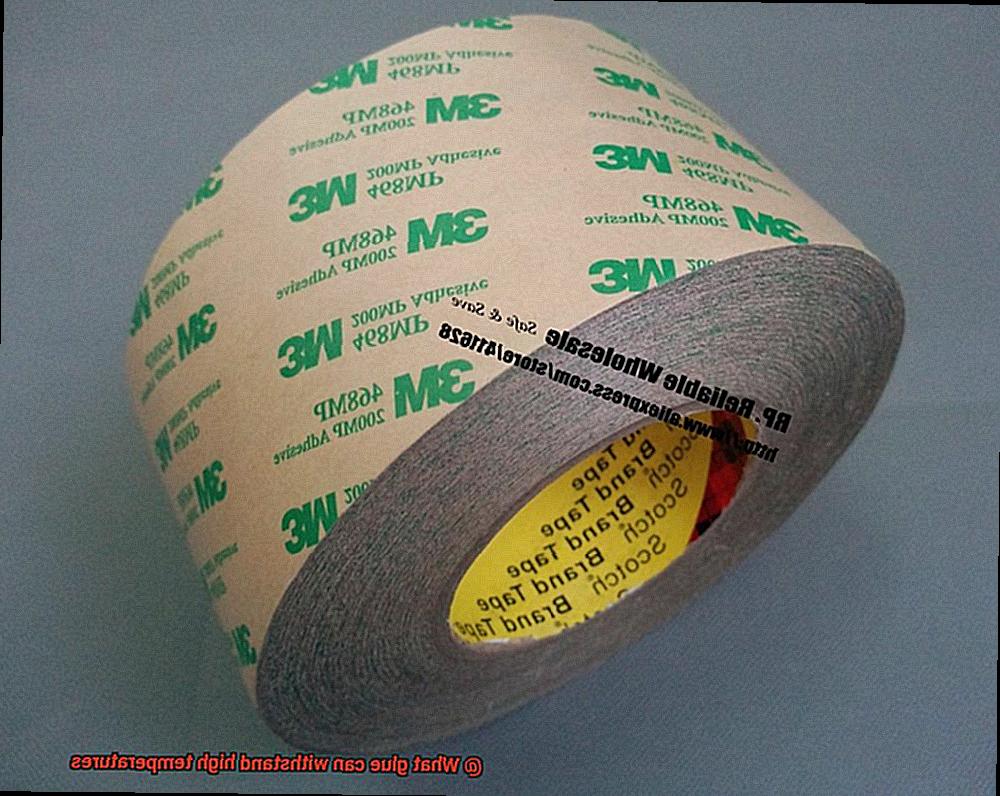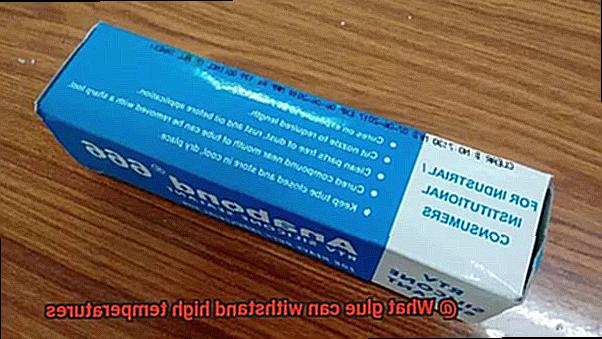Do you ever feel like regular glue just can’t handle the heat? It’s frustrating to spend time on a DIY project, only to have it fall apart when exposed to high temperatures. Lucky for you, there are specialized types of glue that can withstand even the toughest of situations.
From repairing your car’s engine to fixing your favorite frying pan, high-temperature resistant glue is a must-have tool in any DIY enthusiast’s toolbox. But with so many options available, it can be overwhelming to choose the right one for your specific needs.
Factors like intended application, materials being bonded, and required temperature limit all play a role in determining which type of glue will work best. Some glues can handle even the most extreme environments, while others may only offer a partial solution.
In this blog post, we’ll explore various types of high-temperature resistant glue and their advantages and disadvantages. We’ll also provide tips to help you make an informed decision when selecting the perfect adhesive for your needs. So let’s dive in and discover everything you need to know about choosing high-temperature resistant glue.
Factors to Consider When Choosing a Glue for High-Temperature Applications
Contents
- 1 Factors to Consider When Choosing a Glue for High-Temperature Applications
- 2 Silicone Adhesive: An Ideal Choice for High-Temperature Applications
- 3 Epoxy Adhesive: A Durable Option for High-Temperature Bonding
- 4 Cyanoacrylate Adhesive: Superglue for High-Temperature Applications
- 5 The Importance of Considering the Materials Being Bonded
- 6 Other Types of Glues That Can Withstand High Temperatures
- 7 Tips for Choosing the Right Type of Glue
- 8 Conclusion
Whether you’re working in the aerospace, automotive, or industrial sector, selecting the right adhesive is critical to ensure a strong and long-lasting bond. There are several factors to consider when choosing a glue for high-temperature applications.
Temperature Range:
The temperature range that the glue can handle is one of the most critical factors to consider. Different types of adhesives have varying temperature ranges, and it’s crucial to choose one that can withstand the specific temperature requirements of your application. For instance, some adhesives can handle temperatures up to 600°F (315°C), while others can only withstand up to 180°F (82°C).
Substrate Compatibility:
Another factor to consider is the type of substrate that you’re bonding. While high-temperature adhesives may work well on some materials, they may not work on others. It’s important to choose a glue that is compatible with the materials you’re working with. For example, some adhesives may be suitable for bonding metal or ceramic materials, but not for plastic or rubber.
Curing Time:
The curing time of the adhesive is another critical factor to consider. Some adhesives may require a longer curing time to achieve maximum bonding strength, while others may cure quickly. It’s essential to select an adhesive that provides enough time for proper positioning and alignment before it sets.
Chemical Resistance:
The chemical resistance of the adhesive is also vital when choosing a glue for high-temperature applications. Depending on the environment in which the adhesive will be used, it may be exposed to various chemicals or solvents that could weaken its bond over time. Choosing an adhesive with excellent chemical resistance will ensure that it maintains its strength and durability even in harsh environments.
Safety and Environmental Impact:
It’s equally important to consider the safety and environmental impact of the adhesive. Some high-temperature adhesives may contain harmful chemicals or emit toxic fumes during application or curing. Therefore, it’s essential to choose an adhesive that is safe for use and environmentally friendly.
Silicone Adhesive: An Ideal Choice for High-Temperature Applications
Silicone adhesive is a superstar in the world of industrial adhesives, particularly for high-temperature applications. As a specialist in the field, I can attest to the numerous benefits that make silicone adhesive an ideal choice:
First and foremost, silicone adhesive boasts exceptional thermal stability. It can endure a broad range of temperatures, from frigid -65°F to scorching 450°F. This makes it a dependable adhesive for industries that operate in extreme heat or cold. Unlike other adhesives that may degrade, lose bonding strength, or even melt when exposed to high temperatures, silicone adhesive stays stable and reliable.
Another advantage of silicone adhesive is its versatility. It can bond to a wide range of surfaces, including glass, metal, plastic, and rubber. This flexibility makes it a popular choice across many different industries and applications.

Silicone adhesive also has excellent chemical resistance properties. It is impervious to many types of chemicals, including oils, solvents, and acids. This feature makes it the go-to adhesive for applications where exposure to harsh chemicals is common.
Moreover, silicone adhesive offers good electrical insulation properties. It is frequently used in electronic applications to protect electrical components from heat and moisture.
Overall, silicone adhesive is an excellent choice for high-temperature applications due to its thermal stability, versatility, chemical resistance, and electrical insulation properties. It is a dependable and durable adhesive that can withstand even the harshest conditions.
Epoxy Adhesive: A Durable Option for High-Temperature Bonding
Look no further than epoxy adhesives. These powerful adhesives are a popular choice for high-temperature bonding applications due to their exceptional bonding strength and durability.
One of the key advantages of epoxy adhesives is their ability to withstand extreme temperatures. Withstanding temperatures ranging from 250°F to 600°F, depending on the specific formulation and application requirements, they are ideal for use in industries such as aerospace, automotive, and electronics where heat resistance is critical.
But that’s not all – epoxy adhesives offer several other benefits in addition to their high-temperature resistance. They boast excellent chemical resistance, making them resistant to corrosion, solvents, and other harsh chemicals. They also have good dimensional stability, meaning they can maintain their shape and size even under extreme conditions.
It’s important to note that not all epoxy adhesives are suitable for high-temperature bonding applications. You must choose an adhesive that is specifically designed for the intended use and can withstand the required temperature range. Factors such as curing time and viscosity should also be considered when selecting an epoxy adhesive.
Cyanoacrylate Adhesive: Superglue for High-Temperature Applications
When it comes to high-temperature bonding, cyanoacrylate adhesive, also known as superglue, might not be the obvious choice. However, this versatile adhesive has proven itself to be a reliable option for applications that require heat resistance.
One of the standout features of cyanoacrylate adhesive is its ability to resist thermal degradation. With the capacity to withstand temperatures up to 82°C (180°F), it’s no surprise that this adhesive is gaining popularity in industries such as electronics and automotive manufacturing.
What sets cyanoacrylate adhesive apart from other high-temperature adhesives is its ease of use. It can be quickly and easily applied using various methods such as spray, brush, or dropper. Its low viscosity allows it to penetrate small gaps and crevices, resulting in a strong and durable bond.
The versatility of cyanoacrylate adhesive is another factor that makes it an attractive option for high-temperature applications. It can bond a wide range of materials, including metals, plastics, and ceramics. This characteristic makes it useful in various industries and applications.
However, it’s important to note that not all cyanoacrylate adhesives are created equal. Choosing an adhesive that is specifically formulated for heat resistance is crucial for optimal performance.
The Importance of Considering the Materials Being Bonded
Consider this: the materials being bonded are crucial to the success of your project. As an expert in adhesives, I know that different materials have unique properties that require specific types of glue to ensure a strong and lasting bond.

Let’s take metal bonding, for example. If you’re bonding metal, you’ll need an adhesive that can withstand high temperatures and has excellent metal surface adhesion. Two common options are epoxy and cyanoacrylate (super glue). Epoxy bonds exceptionally well with metal surfaces and can tolerate temperatures up to 300°F. In contrast, cyanoacrylate is quick-drying, perfect for small metal parts, and tolerates temperatures up to 250°F.
Now think about plastic bonding. You’ll need an adhesive that works effectively with plastic surfaces and can tolerate high temperatures. Acrylic adhesives are the go-to choice for plastic bonding as they offer superior adhesion to various types of plastics and tolerate high temperatures up to 250°F.
It’s essential to note that not all adhesives are suitable for all materials. Some adhesives may not work well with specific types of plastics or metals. Therefore proper research and identification of the right adhesive are fundamental for a successful bonding process.
Other Types of Glues That Can Withstand High Temperatures
If you’re searching for a glue that can withstand high temperatures, there are various options to consider. While epoxy and silicone adhesives are the most commonly used, there are other types of glue that may be more suitable for certain applications.
Cyanoacrylate Glue:
Cyanoacrylate glue, also known as super glue, can withstand temperatures up to 212°F for short periods. Although it may not be the first choice for high-temperature applications, it’s useful for bonding parts exposed to brief periods of heat. It’s commonly used in electronics and automotive industries due to its excellent bonding properties.
Epoxy Resin:
Epoxy resins are durable and robust adhesives that can withstand high temperatures up to 300°F. They’re frequently used in the automotive industry to bond metals, plastics, and composites. They have excellent strength and durability, making them a reliable choice for high-temperature applications.
Silicone Adhesive:
Silicone adhesive is a popular adhesive that can tolerate temperatures up to 600°F. Its high-temperature tolerance makes it ideal for sealing engines, exhaust systems and other components that generate heat in the automotive industry. It’s commonly used to bond metal, glass, and ceramics in both aerospace and automotive industries.
Acrylic Adhesive:
Acrylic adhesive is another type of adhesive that can withstand high temperatures up to 350°F. It’s often used in the aerospace industry where it bonds metals, plastics, and composites. It has excellent temperature resistance and is a reliable option for high-temperature applications.
Phenolic Adhesive:
Phenolic adhesives are known for their ability to withstand high temperatures up to 350°F. It’s commonly used in the manufacturing of aircraft components where it bonds metals and composites. It has excellent temperature resistance and is easy to use in assembly lines.
Ceramic Adhesive:
Ceramic adhesive is a specialized glue that can withstand extremely high temperatures up to 2000°F. It’s commonly used in industrial settings for furnace repairs or bonding ceramic parts. Its high-temperature tolerance makes it ideal for high-temperature applications in extreme conditions.
Tips for Choosing the Right Type of Glue
Selecting the right type of glue that can withstand high temperatures is crucial for any project, big or small. You want to ensure that your bond remains strong and durable, even under extreme heat. To help you choose the right heat-resistant glue, here are five factors to consider:
Type of Adhesive
To begin, it’s important to note that not all adhesives can withstand high temperatures. Epoxy, silicone, polyurethane-based adhesives, and cyanoacrylate (super glue) are all types of heat-resistant glue that are designed to hold up well under extreme heat. Be sure to check the label before purchasing to ensure the glue is heat-resistant.
Temperature Range
Different types of adhesives can handle different temperature ranges. Some can withstand temperatures up to 600°F (315°C) while others only up to 180°F (82°C). It’s crucial to choose a glue that can handle the highest temperature that your project requires.
Application
The application method of the glue is also essential to consider. Some adhesives require mixing or special applicators, while others come in easy-to-use tubes or spray cans. Choose a glue that is easy for you to use and fits your specific application needs.
Materials Being Bonded
Different types of glue work better on different surfaces, so it’s crucial to choose a glue that is specifically designed for the materials you will be bonding together. For example, if you need to bond metal, a high-temperature silicone adhesive or epoxy adhesive may be the best choice.
Curing Time
Finally, consider how much time you have for the adhesive to cure before choosing a glue. Some heat-resistant adhesives require longer curing times than others. Be sure to factor this into your decision-making process and choose an adhesive that will fit your timeline.
A15EjGks83Q” >
Conclusion
In conclusion, the importance of selecting the right glue for high-temperature applications cannot be overstated. A strong and long-lasting bond is essential, and various factors like temperature range, substrate compatibility, curing time, chemical resistance, and safety must be considered when choosing an adhesive.
For those seeking an ideal choice for high-temperature applications, silicone adhesive stands out due to its thermal stability, versatility, chemical resistance, and electrical insulation properties. Epoxy adhesive is another durable option that can withstand extreme temperatures while maintaining excellent chemical resistance. And although not an obvious choice for high-temperature bonding, cyanoacrylate adhesive has also proven to resist thermal degradation well.
Beyond these options, there are other types of adhesives available that can withstand high temperatures such as acrylic, phenolic, and ceramic adhesives. However, regardless of the type of glue selected for your project, it’s crucial to consider factors like temperature range, application method, materials being bonded and curing time.
In summary, with specialized types of glue available that can withstand even the toughest situations; you can now take on DIY projects with confidence knowing that your bond will remain strong even under extreme heat conditions.






